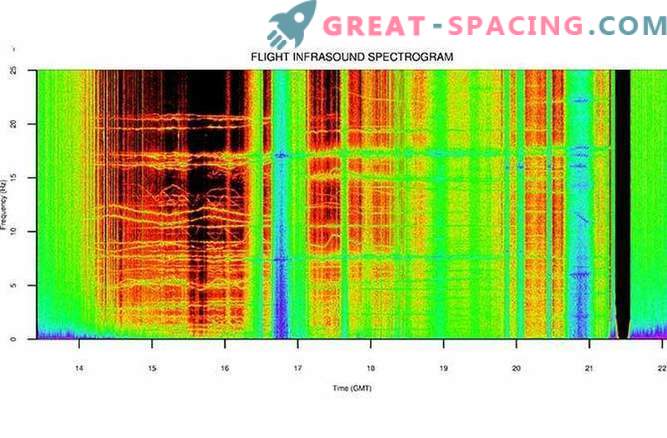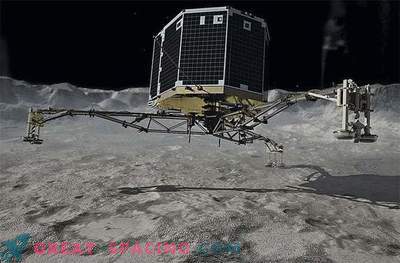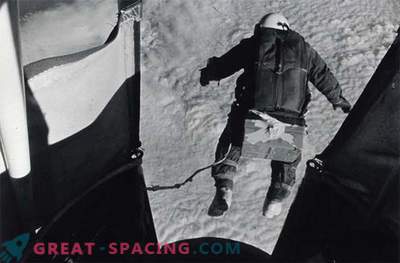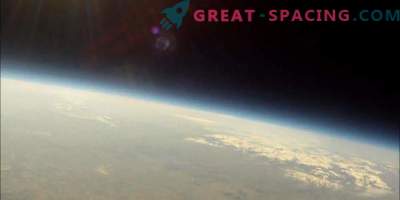
An eerie sound at the edge of the atmosphere was recorded for the first time in 50 years aboard a balloon from a NASA student experiment.
Microphones that capture the infrasound recorded a mysterious whistle and hiss at 36 km from the surface of the earth last year. Daniel Bauman, a graduate student at the University of North Carolina, designed and built a special device that caught the atmospheric infrasound — sound waves that are heard to a person only after the recording was enhanced.
“These sounds are similar to those in the X-Files,” Bowman told Live Science.
Helium balloon with infrasound sensors flew over Arizona and New Mexico on August 9, 2014. It was one of 10 payloads launched as part of the HASP student program. High-altitude ballooning is an annual project that is conducted by NASA and the Louisiana State Space Consortium, with the help of which scientists hope to increase students' interest in space research. Since 2006, more than 70 experimental devices developed by students of the United States have been launched as part of HASP.
During the 9-hour flight the balloon with the payload traveled about 725 km and reached an altitude of more than 37.5 km. This is an area of near-Earth space — higher than airplanes fly, but below the upper boundary of the stratosphere (100 km from the surface of the earth). “None of the experiments on the study of infrasonic signals has ever been done so highly,” said Bowman. Interest in atmospheric infrasound was maximal in the 1960s, when it was used to detect nuclear explosions, but then the research was completed as scientists switched to ground-based sensors.
The fact that the HASP ball sensors recorded a mix of signals, the scientists are working on interpreting, Bowman reported at the meeting of the Seismological Society of America in Pasadena on April 23. Researchers have never “heard” so many stratospheric signals.
Here are some of the assumptions of the origin of the record: it could be the sounds from wind power stations that got in the way of flight, or crashing ocean waves, or air turbulence, or gravitational waves, or vibrations from a ball cable. Scientists plan to launch another payload in 2015 as part of HASP, which will be able to reveal more information about the infrasound sources.
“I was surprised by the complexity of the signal,” said Bowman. “I expected to see only a few small spectral bands.”
Bowman, who builds and launches high-altitude balloons from school, hopes that his experiment will revive interest in atmospheric infrasound. “Over the past 50 years, not a single acoustic record has been made in the stratosphere. Of course, if we place the equipment there, we will find something we did not know about before, ”he said. The infrasound is transmitted over long distances (remember that the sound of thunder is heard much further than the bright lightning is visible). Earthquakes, storms, volcanic eruptions, meteors and landslides all produce infrasonic sound waves. “Monitoring turbulence in clean air or trapping air from jet planes is potentially possible,” said Bowman. Together with his curator Jonathan Liis, Bowman hopes to record infrasound from an erupting volcano.
It was proposed to send such sensors to Venus and Mars, where microphones could detect unusual weather or earthquakes.
“Some natural infrasonic signals can be better captured in the atmosphere,” said Omar Marcillo, a geophysicist at the Los Alamos National Laboratory, who did not participate in the study. “The atmosphere refracts sound waves, so some infrasonic signals may not reach the ground. Interference from noise emitted by civilization also decreases in the sky. ”
“I think this work will be the beginning for many further studies,” said Marcillo. “It is very important.”











































